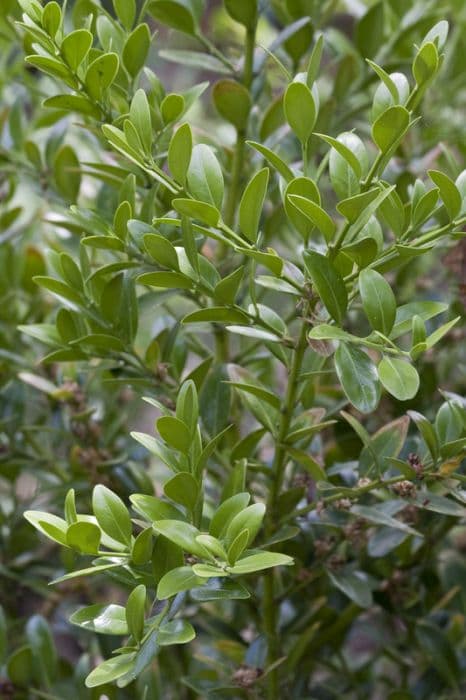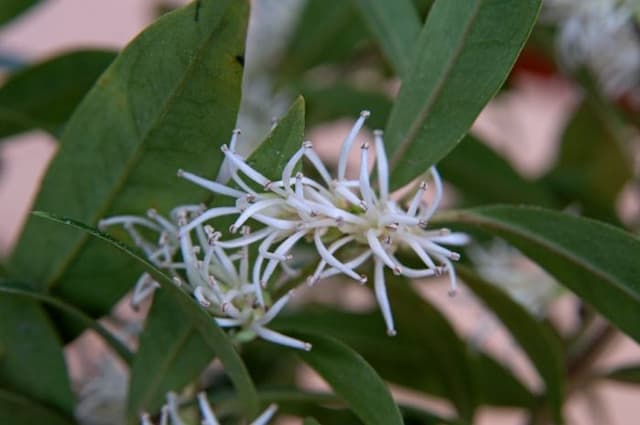Sweetbox Sarcococca hookeriana var. humilis

ABOUT
The plant commonly known as sweet box is a lush, evergreen shrub that boasts a dense thicket of glossy, dark green leaves which are leathery to the touch and present a pointed, elongated shape. Throughout the late winter to early spring, this plant comes alive with an abundance of tiny, yet incredibly fragrant, white flowers. These flowers exude a sweet scent that can be detected even at a distance, often described as enchanting or honey-like, adding an aromatic allure to the garden. Following the flowering period, the sweet box may develop small, spherical berries that transition in color from red to a shiny, deep black as they mature. This berry display adds a further visual interest and can attract birds and other wildlife to the garden. The plant's branches tend to grow in a dense, compact form which gives the shrub a neat and tidy appearance throughout the year, making it an ideal choice for low hedges or groundcover in shady garden spots where its rich foliage can create a striking contrast against lighter, airy plants or open spaces.
About this plant
 Names
NamesSynonyms
Dwarf Sweet Box, Himalayan Sweet Box, Christmas Box
Common names
Sarcococca humilis, Sarcococca hookeriana var. digyna, Sarcococca ruscifolia var. chinensis.
 Toxicity
ToxicityTo humans
Sweet box is not widely regarded as a poisonous plant to humans. There is limited information about its toxicity, as it is not commonly consumed. If ingested in large quantities, it could potentially cause some digestive discomfort, but typically it is not considered dangerous. Care should always be taken with children and pets, as individual reactions can vary. If any part of the plant is ingested and symptoms appear, medical advice should be sought.
To pets
Sweet box is generally not known for being toxic to pets. However, it is always advisable to prevent pets from ingesting plants. Some animals might experience mild gastrointestinal upset if they consume parts of the sweet box, but severe toxicity is unlikely. If you suspect your pet has ingested sweet box and is showing symptoms of distress, consult your veterinarian.
 Characteristics
CharacteristicsLife cycle
Perennials
Foliage type
Evergreen
Color of leaves
Dark green
Flower color
White
Height
1-2 feet (30-60 cm)
Spread
1-2 feet (30-60 cm)
Plant type
Shrub
Hardiness zones
6-9
Native area
Himalayas
Benefits
 General Benefits
General Benefits- Aesthetic Appeal: Sweet box is an evergreen shrub that provides year-round visual interest with its glossy green leaves, adding structure and consistency to garden landscapes.
- Low Maintenance: This plant is known for being easy to care for, requiring minimal pruning and being tolerant of a range of soil types and conditions.
- Fragrant Flowers: Sweet box produces small, highly fragrant white flowers in late winter to early spring, which can be a delightful and early source of scent in the garden at a time when few other plants are blooming.
- Shade Tolerance: It thrives in partial to full shade, making it suitable for planting in understory areas or north-facing gardens where much other flora might struggle.
- Drought Resistant: Once established, sweet box is fairly drought-tolerant, reducing the need for frequent watering and making it suitable for xeriscaping or areas with water restrictions.
- Berries for Wildlife: After flowering, sweet box produces black berries that can provide a food source for birds and other wildlife.
- Ground Cover: With its low, spreading habit, sweet box can be used to provide dense ground cover, suppressing weeds and reducing soil erosion.
- Winter Interest: Its persistent foliage, fragrant flowers, and sometimes berries offer visual interest and a splash of green during the dull winter months.
- Border Planting: Sweet box can be utilized in border plantings, making an attractive year-round edge for garden beds or pathways.
- Container Friendly: This plant can be grown in containers, providing flexibility to move it around or incorporate it into patio gardens and other small spaces.
 Medical Properties
Medical PropertiesThis plant is not used for medical purposes.
 Air-purifying Qualities
Air-purifying QualitiesThis plant is not specifically known for air purifying qualities.
 Other Uses
Other Uses- Sweet Box can be used as a natural insect repellent, as some insects are deterred by its fragrance.
- It's often planted in urban areas for its ability to thrive in heavy shade and tolerate pollution.
- The dense foliage of Sweet Box is utilized in gardens to create low, evergreen ground cover that suppresses weeds.
- Sweet Box berries are occasionally used in floral arrangements, providing a unique touch with their glossy appearance.
- It can be crafted into a natural hedge or border due to its uniform growth habit.
- Gardeners may use clippings of Sweet Box to propagate new plants, as it roots readily from cuttings.
- The thick leaves of Sweet Box make it a useful plant for preventing soil erosion on slopes and banks.
- Some cultures use the aromatic leaves of Sweet Box in small pouches to freshen up clothes and linens in drawers.
- The wood of Sweet Box, while not commonly used, can be crafted into small objects like inlays for decorative woodworking.
- Because of its sturdy nature, Sweet Box is sometimes planted in cemeteries as a symbolic and low-maintenance greenery choice.
Interesting Facts
 Feng Shui
Feng ShuiThe Sweet Box is not used in Feng Shui practice.
 Zodiac Sign Compitability
Zodiac Sign CompitabilityThe Sweet Box is not used in astrology practice.
 Plant Symbolism
Plant Symbolism- Persistence: Sarcococca hookeriana var. humilis, commonly known as sweet box or Christmas box, remains evergreen throughout the year, symbolizing persistence and the ability to endure challenges over time.
- Protection: Sweet box is often used in gardens as a low-growing hedge, which can be seen as a symbol of protection, guarding the space within.
- Modesty: Despite being highly fragrant when in bloom, sweet box maintains a humble and unassuming appearance, representing modesty.
- Renewal: Blooming in late winter or early spring, sweet box represents renewal and the promise of new beginnings as it is one of the first signs of life after the winter's dormancy.
 Water
WaterSweet box prefers to be kept in evenly moist soil, so it should be watered when the top inch of soil feels dry to the touch. This typically means watering approximately once a week, but this can vary depending on climate and indoor conditions. During the growing season, in spring and summer, it may need watering more frequently. Use about 1 gallon of water each time for a medium-sized plant to ensure deep hydration. In winter, reduce watering to every other week or less, depending on the humidity and temperature of your environment.
 Light
LightSweet box thrives in partial to full shade conditions, making it ideal for spots that don't receive intense sunlight. It can handle a bit of morning sun, but should be protected from strong afternoon rays. The best spot for sweet box is therefore under the canopy of larger trees, on the north or east side of buildings, or any location where it can enjoy diffused light without being exposed to prolonged direct sunlight.
 Temperature
TemperatureSweet box is hardy and can tolerate a range of temperatures; however, it performs best in areas where the temperature remains between 60 to 80 degrees Fahrenheit. It can survive minimum temperatures down to around 0 degrees Fahrenheit, but it's important to protect it from harsh winter winds. Ensure the plant is mulched and possibly covered during extreme cold to prevent damage to the root system.
 Pruning
PruningSweet box benefits from pruning to maintain its shape and encourage denser growth. Prune in late winter or early spring before new growth starts. Remove any dead or damaged branches and lightly shape the plant as desired. Since sweet box is a slow grower, it generally doesn't require frequent pruning, so doing this task once a year is often sufficient.
 Cleaning
CleaningAs needed
 Soil
SoilSweet Box prefers well-drained soil rich in organic matter with a pH range of 5.5 to 6.5. An ideal mix would consist of garden loam, peat moss, and perlite in equal parts to ensure good drainage and aeration. Adjust pH with sulfur or lime if necessary.
 Repotting
RepottingSweet Box seldom needs repotting; do it every 3-5 years or if it outgrows its container. Repot in spring using a slightly larger pot to avoid excessive root disturbance.
 Humidity & Misting
Humidity & MistingSweet Box tolerates a wide range of humidity levels; however, it prefers moderate humidity. Aim for 40-60% for optimal growth, which is typically achieved in an average home environment.
 Suitable locations
Suitable locationsIndoor
Place Sweet Box near a window; water when topsoil is dry.
Outdoor
Plant Sweet Box in partial shade; water regularly.
Hardiness zone
6-9 USDA
 Life cycle
Life cycleSweet Box (Sarcococca hookeriana var. humilis) starts its life cycle when seeds germinate in spring, under the right conditions of moisture and temperature. The seedlings then develop a root system and foliage as they enter the vegetative growth phase, establishing themselves as young plants. Through the growing season, they mature into small, evergreen shrubs with glossy green leaves. Once mature, typically after a couple of years, Sweet Box will produce small, fragrant white flowers in late winter to early spring. After pollination, usually by insects attracted to the fragrance, the flowers develop into small, black berry-like fruits that contain seeds. The seeds are dispersed by animals or gravity, ready to germinate and start the life cycle anew if they land in a conducive environment.
 Propogation
PropogationPropogation time
Early Spring
Sarcococca hookeriana var. humilis, commonly known as sweet box or Christmas box, is often propagated through semi-ripe cuttings. The best time to propagate this plant is in late summer. One would begin by selecting a healthy shoot and cutting a length of approximately 4 to 6 inches (about 10 to 15 centimeters), ensuring that several leaves are present. The cut end is then dipped in rooting hormone to encourage root development. This treated cutting is then inserted into a pot filled with a well-draining potting mix, with about half of the cutting's length buried in the soil. The pot is then placed in a warm area with indirect light and the soil is kept consistently moist. Roots typically develop within several weeks, after which the new plants can be gradually acclimatized to outdoor conditions and eventually transplanted into the garden.





![Sweet box [Winter Gem]](/_next/image?url=https%3A%2F%2Fplants-admin.emdemapps.com%2Fimages%2Fplants%2F%2Fimages%2F604b6267b442c.png&w=640&q=75)



